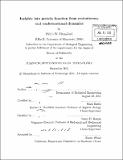Insights into protein function from evolutionary and conformational dynamics
Author(s)
Bransford, Philip W
DownloadFull printable version (16.55Mb)
Other Contributors
Massachusetts Institute of Technology. Dept. of Biological Engineering.
Advisor
Mark Bathe and Roger D. Kamm.
Terms of use
Metadata
Show full item recordAbstract
The volume of protein structure data has grown rapidly over the past 30 years, leaving a wake of facts that still require explanation. We endeavored to answer a few open questions on the structure-function relationship of intriguing mechanochemical protein systems. To this end this thesis work contains five studies that offer novel insights into molecular biomechanical systems that may guide future basic research or applications development. The first study concerns the biophysics of cadherin-mediated cell sorting observed in developing solid tissue. We investigated the evolutionary dynamics of the cadherin superfamily of cell-cell adhesion proteins to infer a structural basis for their paradoxical mixture of pairwise binding specificity and promiscuity. Our analysis predicts a small set of specificity-determining residues located within the protomer-protomer binding interface. The putative specificity-determinants form a design space with potential for engineering novel cell-cell adhesive interactions. The second study addresses the open question of how to automatically identify regions within a protein that engage in allosteric communication. To identify allostery we developed and tested two computational tools that operate on protein conformational dynamics data. These tools are useful for generating testable hypotheses about proteins with multiple functional sites for the design of non-competitive protein inhibitors. The third study asks, "What is the consequence of allosteric cooperation between the tandem binding sites in a class of proteins that bundle filamentous actin (F-actin)?" Through simulation we demonstrate that cooperative F-actin bundling tends to strengthen bundles by driving the formation of cross-links between neighboring filaments while depleting F-actin binding sites that are occupied but not cross-linked. We hence propose that allostery may be a natural feature of ABPs with tandem F-actin binding sites if nature indeed selects for sturdy F-actin bundles. The final two studies examine the impact of two structural perturbations to Factin on its mechanics. Using structure-based computer modeling we develop a simple explanation for the mechanism by which the structure of actin's polymorphic subdomain 2 mediates 4-fold changes in F-actin's flexibility. We further demonstrate that two calponin homology domains stabilize F-actin by binding in a configuration that tends to relax the stress concentration at actin-actin interfaces.
Description
Thesis (Ph. D.)--Massachusetts Institute of Technology, Dept. of Biological Engineering, 2011. Cataloged from PDF version of thesis. Includes bibliographical references (p. 125-144).
Date issued
2011Department
Massachusetts Institute of Technology. Department of Biological EngineeringPublisher
Massachusetts Institute of Technology
Keywords
Biological Engineering.